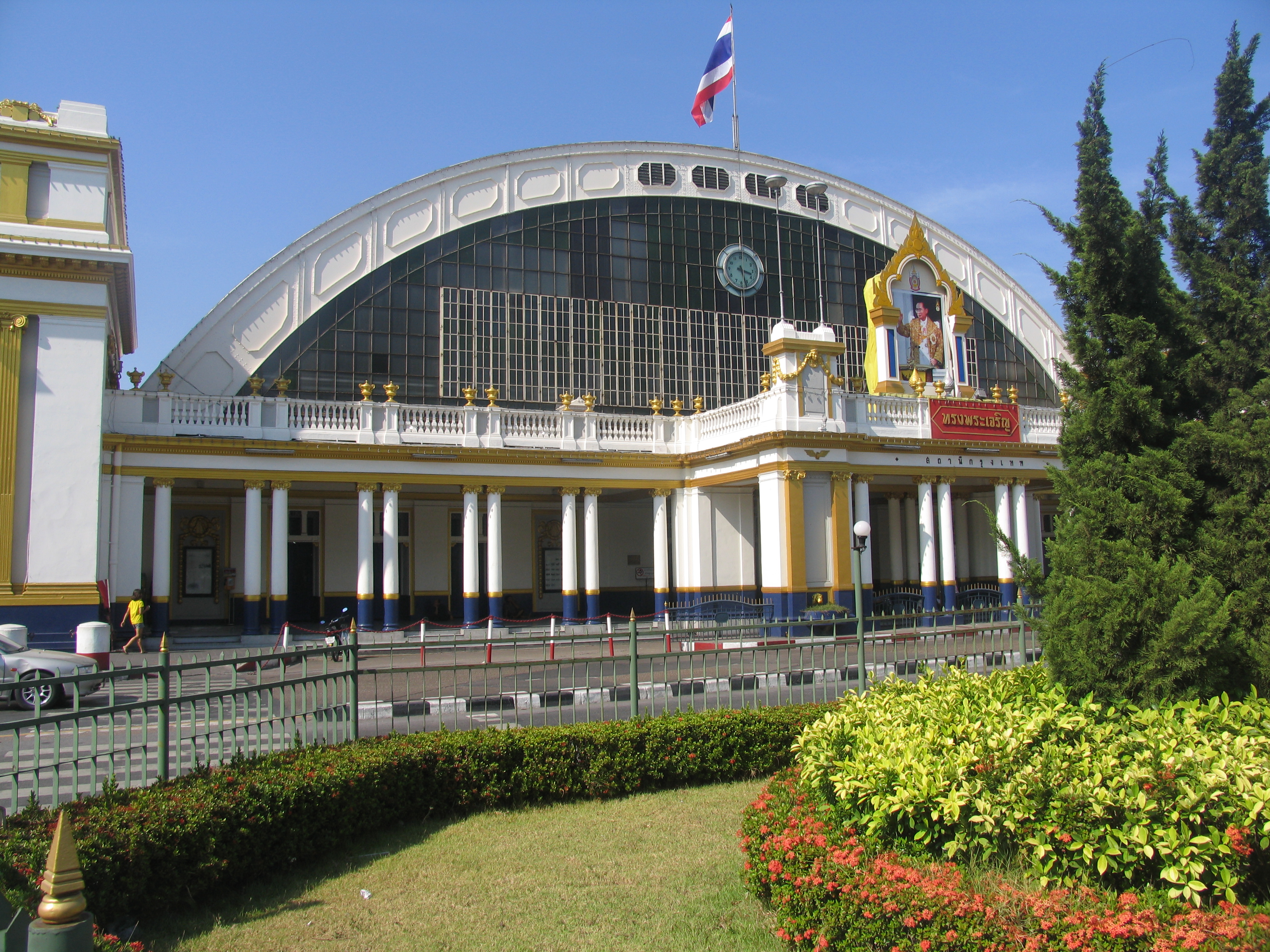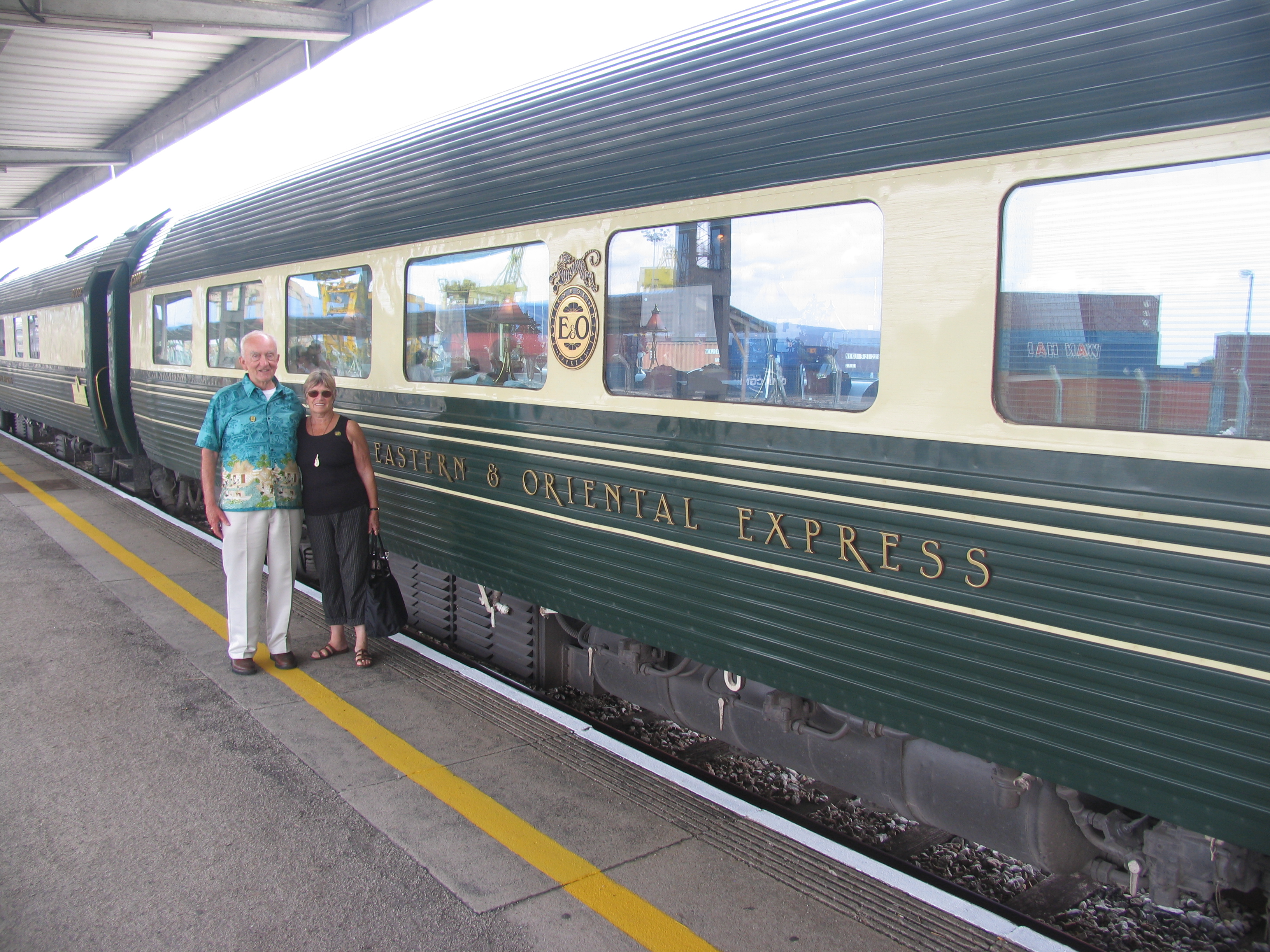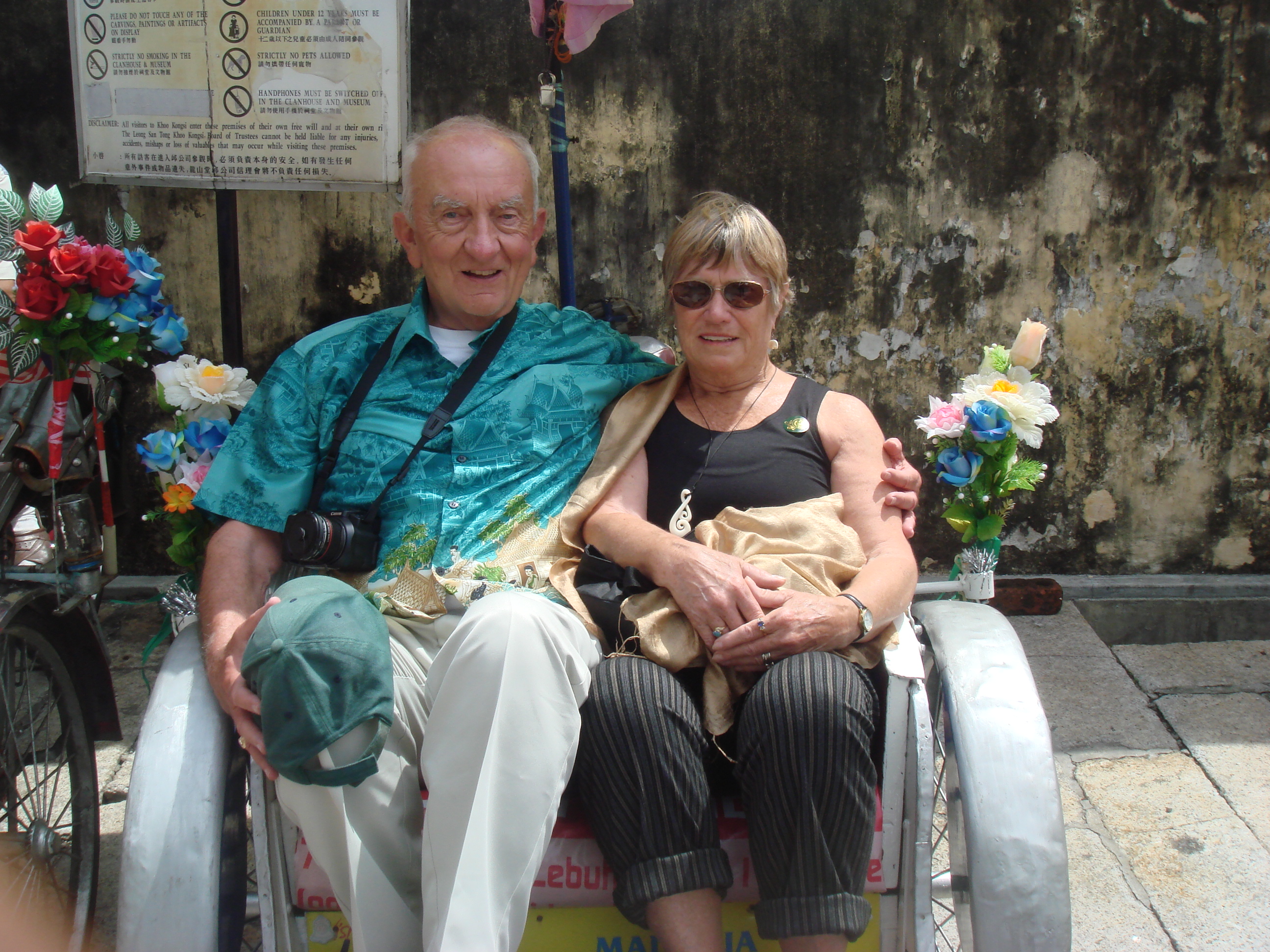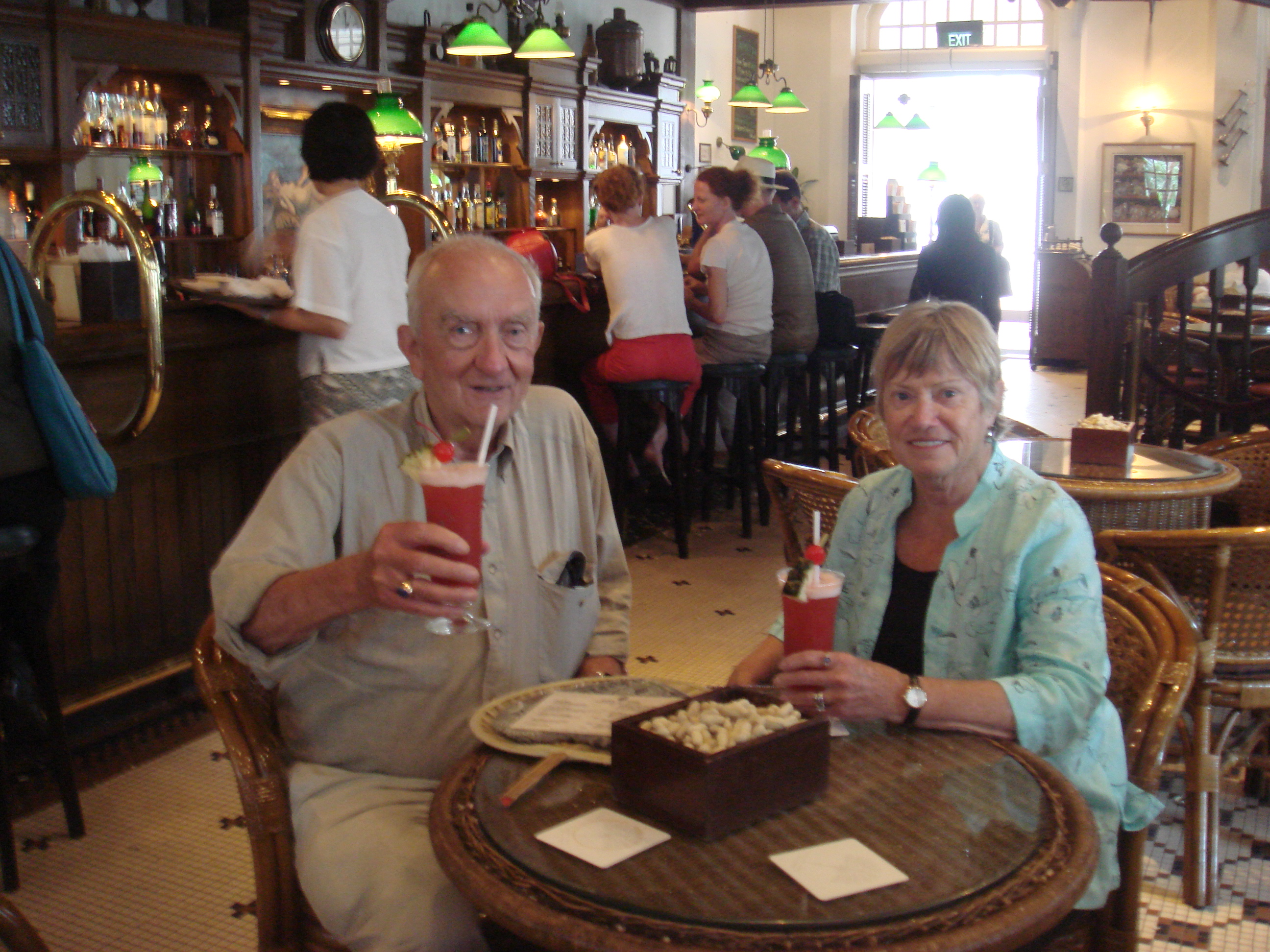

Malaysia (2008)
A Ride on the Orient Express
When political unrest in Burma caused us to cancel our cruise up the Irrawaddy River to Mandalay, we chose instead to replace it with journey by train down the Malay Peninsula from Bangkok to Singapore on the fabled Eastern and Orient Express.
 |
 |
Hualampong Train Station, Bangkok Mystery Passengers on the Orient Express Train
Intrigued by the classic 1974 movie Murder on the Orient Express, based on the mystery novel by Agatha Christie, we have always wanted to take a train journey on the Orient Express, joining that select group of distinguished passengers on an exotic journey to far-off foreign destinations. That train of our dreams was the legendary Venice-Simplon Orient Express that transported the rich and famous between London and Istanbul for over a century following its maiden run in 1883.
But, when the opportunity presented itself to travel on the Asian version of the Orient Express, we jumped at the chance. Every bit as elegant but without the long and glamorous history, our Eastern and Orient Express train has been providing service down the Malay Peninsula from Bangkok to Singapore through the heart of Southeast Asia for only the past 15 years. The E&O travels a total 1,165 miles on its three day journey through Thailand, Malaysia and Singapore. In name, at least, one might conclude that it is the “true Orient Express”
As we gathered in the E & OE reception room at the Hualampong station in Bangkok to await the train, we scanned the other passengers hoping to spot a Hungarian princess, an exiled royal from the Balkans or a celebrity in disguise. Perhaps overly preconditioned by the old movie, we did spot several who looked a bit like Ingrid Bergman, Lauren Bacall, Sean Connery and Hercule Poirot
At 5 pm, we were escorted to the train, a sleek, quarter-mile-long green serpent waiting on a distant platform. The train is made up of 21 cars -16 sleeping cars, two restaurant cars, a club car with piano bar, a reading car and an open-air observation car at the rear. For the next three days and four nights, it was a rolling home to 75 passengers and 50 crew members.
Val and I were escorted to our stateroom by a uniformed cabin attendant. Our compartment was paneled in rich mahogany and cherry wood with distinctive inlaid designs done by local artists. It was furnished with a sofa (which was made up into two beds each evening), a large viewing window and our own bathroom and shower with all of the pampering touches including bathrobes and towels, fresh flowers and a basket of fine English soaps and lotions. Plus we had our very own cabin steward who served our breakfast in bed, brought us our afternoon tea and who was there to indulge us 24 hours a day.
We knew that our journey was off to an auspicious start when we found a bottle of chilled champagne waiting for us in our compartment, compliments of the Orient Express staff along with a note congratulating us on our 50th anniversary.
Shortly after the train got underway we were called to dinner in one of the two the elegant dining cars. The tables were set with French silverware, crystal glasses and fine linens and. We had been prepared for the dress code by a pre-trip booklet which advised: “In the evenings, gentlemen will feel comfortable with a minimum of jacket and tie, however the ambience of the train provides a marvelous opportunity to display some glamour and style and dressing up is encouraged”. Having filled our suitcases with woolens and long underwear in anticipation of some cold nights in tents in the high Himalayas in Bhutan, we found ourselves a bit ‘wardrobe challenged’ but I managed to meet the minimum requirements and Valerie was absolutely stunning as always.
The restaurants on the train were worthy of five stars. The waiters were dressed in green brocade vests and the service was impeccable. The menus included such things as goose liver truffles, grilled escolar and tiger prawns with mango sauce. And those were just the appetizers! Given a choice between a table for two and a table for four, we opted to share our tables and were fortunate to be joined by four different and delightful couples from England, Scotland, U.S. and Australia, whose dinner company we enjoyed very much.
The train stopped for two excursions in the course of the trip. The first was at the River Kwai to see the bridge made famous by the movie “The Bridge on the River Kwai”. We had a chance to visit the very moving museum depicting the construction of the Thai-Burma railway, better know as the “Death Railway”, during World War II which cost the lives of 20,000 allied prisoners of war and over 50,000 native laborers. We concluded our stop with a visit to the War Cemetery, the final resting place for 7,000 British and Dutch POWs who perished there constructing the bridge.
 |
 |
The Bridge on the River Kwai Trishaw Riders, Panang, Malaysia
Our second stop was at Penang Island, the oldest British settlement in Malaysia once known as Spice Island, dating back to 1786 and the British East India Company. Reached by a 15 minute ferry ride from Butterworth on the mainland, we were met at the landing by an army of pedal rickshaws that carried us through the colorful streets of old George Town.
Our finest sightseeing, though, was through the window of our compartment or from the open-air observation car at the back of the train. As Agatha Christie said: “Trains are wonderful. To travel by train is to see nature and human beings, towns and churches and rivers. In fact, it is to see life”. For three days we were spectators to life along the rail line. As we proceeded down the Malay Peninsula, we watched as the rice paddies were replaced by rubber tree and palm oil plantations, as the golden temples of Buddhist Thailand turned in to mosques in Moslem Malaysia and as the temperatures increased from hot to hotter as we approached to within one degree of the equator at Singapore.
 |
 |
Palm Oil Plantation from Observation Car Singapore Sling at the Raffles Hotel, Singapore
On our fourth and final day the train crossed the Straits of Johor and pulled into the terminal in Singapore. We capped our journey with a traditional Singapore Sling on the porch of the venerable Raffles Hotel. It had been a trip of a lifetime. The Orient Express fully deserves its glamorous reputation. It is the thing of novels, stories told at dinner tables and the stuff of great memories.
As the travel writer, Paul Theroux, wrote, “It is not the destination but the journey that counts”. From Bhutan to Thailand to Laos to Malaysia and finally Singapore, it was a truly memorable journey and a magnificent way to celebrate our 50 years of marriage.